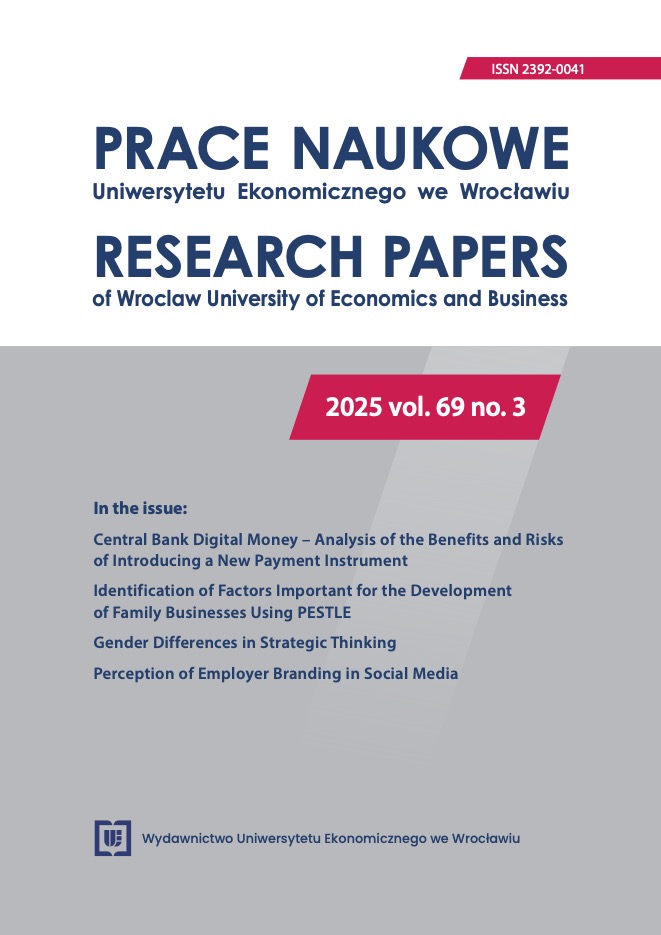Artificial Intelligence in Multimorbidity Care: A Systematic Review of Opportunities; Challenges and Limitations
DOI:
https://doi.org/10.15611/pn.2025.3.03Keywords:
multimorbidity, artificial intelligence, systematic review, PRISMAAbstract
Aim: This study identified AI’s role in supporting patients with multimorbidity in primary healthcare and explored associated opportunities, challenges, and limitations.
Methodology: A systematic literature search was conducted in Scopus, Web of Science, and PubMed using terms related to AI and multimorbidity in PHC. After screening, 53 articles met inclusion criteria and were analysed per PRISMA guidelines.
Results: AI can support multimorbidity patients through personalized treatment, clinical support, virtual assistance and coordinated care via monitoring and interventions. However, adoption remains limited by poor data quality, disease interactions, low model interpretability and underrepresentation of multimorbid populations in training data. Consequently, AI’s role in supporting multimorbidity patients remains limited, with potential benefits unrealized.
Implications and recommendations: Realizing AI’s potential for multimorbidity patients requires addressing technical, ethical, clinical and systemic challenges. Research must prioritize developing representative datasets and interpretable models that capture multimorbidity’s complexity to help deliver coordinated, patient-centred care.
Originality/value: This analysis shows limited AI integration in multimorbidity care, highlighting the need for quality data and interpretable models. It identifies key challenges that must be overcome to transform AI from conceptual promise to practical support for individuals with multimorbidity.
Downloads
References
Abuzour, A. S., Wilson, S. A., Woodall, A. A., Mair, F. S., Clegg, A., Shantsila, E., Gabbay, M., Abaho, M., Aslam, A., Bollegala, D., Cant, H., Griffiths, A., Hama, L., Leeming, G., Lo, E., Maskell, S., O’Connell, M., Popoola, O., Relton, S., & Walker, L. E. (2024). A Qualitative Exploration of Barriers to Efficient and Effective Structured Medication Reviews in Primary Care: Findings from the DynAIRx study. PLoS ONE, 19(8), 1-18. https://doi.org/10.1371/journal.pone.0299770
Ahmad, S., & Azeez, N. P. A. (2023). The Digitalization of India’s Healthcare System: A Paradigm Shift amidst the COVID-19 Pandemic. South Asian Journal of Social Studies and Economics, 19(4), 1-12. https://doi.org/10.9734/sajsse/2023/v19i4681
Akerkar, R. (2019). Artificial Intelligence for Business. Springer.
Akyon, S. H., Akyon, F. C., & Yılmaz, T. E. (2023). Artificial Intelligence-Supported Web Application Design and Development for Reducing Polypharmacy Side Effects and Supporting Rational Drug Use in Geriatric Patients. Frontiers in Medicine, 10(March), 1-16. https://doi.org/10.3389/fmed.2023.1029198
Alghalyini, B. (2023). Applications of Artificial Intelligence in the Management of Childhood Obesity. Journal of Family Medicine and Primary Care, 12, 2558-2564.
Alowais, S., Alghamdi, S. S., Alsuhebany, N., Alqahtani, T., Alshaya, A. I., Almohareb, S. N., Aldairem, A., Alrashed, M., Saleh, K. B., Badreldin, H. A., Al Yami, M. S., Al Harbi, S., & Albekairy, A. M. (2023). Revolutionizing Healthcare: The Role of Artificial Intelligence in Clinical Practice. BMC Medical Education, 23, 689. https://doi.org/10.1186/s12909-023-04698-z
Álvarez-Gálvez, J., Ortega-Martín, E., Carretero-Bravo, J., Pérez-Muñoz, C., Suárez-Lledó, V., & Ramos-Fiol, B. (2023). Social Determinants of Multimorbidity Patterns: A Systematic Review. Frontiers in Public Health, 11.
Amisha, Malik, P., Pathania, M., & Rathaur, V. (2019). Overview of Artificial Intelligence in Medicine. Journal of Family Medicine and Primary Care, 8, 2328-2331.
Bajwa, J., Munir, U., Nori, A., & Williams, B. (2021). Artificial Intelligence in Healthcare: Transforming the Practice of Medicine. Future Healthcare Journal, 8(2), e188-e194. https://doi.org/10.7861/fhj.2021-0095
Balyan, R., Crossley, S. A., Brown, W., Karter, A. J., McNamara, D. S., Liu, J. Y., Lyles, C. R., & Schillinger, D. (2019). Using Natural Language Processing and Machine Learning to Classify Health Literacy from Secure Messages: The ECLIPPSE Study. PLoS ONE, 14(2), 1-17. https://doi.org/10.1371/journal.pone.0212488
Baxter, R., Nind, T., Sutherland, J., McAllister, G., Hardy, D., Hume, A., Macleod, R., Caldwell, J., Krueger, S., Tramma, L., Teviotdale, R., Gillen, K., Scobbie, D., Baillie, I., Brooks, A., Prodan, B., Kerr, W., Sloan-Murphy, D., Herrera, J. F. R., & Jefferson, E. (2024). The Scottish Medical Imaging Archive: 57.3 Million Radiology Studies Linked to Their Medical Records. Radiology: Artificial Intelligence, 6(1), 1-6. https://doi.org/10.1148/ryai.220266
Bensken, W. P., Vaca, G. F. B., Williams, S. M., Khan, O. I., Jobst, B. C., Stange, K. C., Sajatovic, M., & Koroukian, S. M. (2023). Disparities in Adherence and Emergency Department Utilization among People with Epilepsy: A Machine Learning Approach. Seizure, 110, 169-176. https://doi.org/10.1016/j.seizure.2023.06.021
Bousquet, J., Schünemann, H. J., Sousa-Pinto, B., Zuberbier, T., Togias, A., Samolinski, B., Bedbrook, A., Czarlewski, W., Hofmann-Apitius, M., Litynska, J., Vieira, R. J., Anto, J. M., Fonseca, J. A., Brozek, J., Bognanni, A., Brussino, L., Canonica, G. W., Cherrez-Ojeda, I., Cruz, A. A., & Zidarn, M. (2024). Concepts for the Development of Person-Centered, Digitally Enabled, Artificial Intelligence-Assisted ARIA Care Pathways (ARIA 2024). Journal of Allergy and Clinical Immunology: In Practice, Aria. https://doi.org/10.1016/j.jaip.2024.06.040
Brummel, A., & Carlson, A. M. (2016). Comprehensive Medication Management and Medication Adherence for Chronic Conditions. Journal of Managed Care and Specialty Pharmacy, 22(1), 56-62. https://doi.org/10.18553/jmcp.2016.22.1.56
Burnazovic, E., Yee, A., Levy, J., Gore, G., & Abbasgholizadeh Rahimi, S. (2024). Application of Artificial Intelligence in COVID-19-Related Geriatric Care: A Scoping Review. Archives of Gerontology and Geriatrics, 116(December 2022), 105129. https://doi.org/10.1016/j.archger.2023.105129
Cassell, A., Edwards, D., Harshfield, A., Rhodes, K., Brimicombe, J., Payne, R., & Griffin, S. (2018). The Epidemiology of Multimorbidity in Primary Care. British Journal of General Practice, 68(669), 1-7. http://bjgp.org/content/early/2018/03/12/bjgp18X695465
Chowdhury, S. R., Chandra Das, D., Sunna, T. C., Beyene, J., & Hossain, A. (2023). Global and Regional Prevalence of Multimorbidity in the Adult Population in Community Settings: A Systematic Review and Meta-Analysis. EClinicalMedicine, 57, 101860. https://doi.org/10.1016/j.eclinm.2023.101860
Chu, W. M., Kristiani, E., Wang, Y. C., Lin, Y. R., Lin, S. Y., Chan, W. C., Yang, C. T., & Tsan, Y. T. (2022). A Model for Predicting Fall Risks of Hospitalized Elderly in Taiwan – A Machine Learning Approach Based on Both Electronic Health Records and Comprehensive Geriatric Assessment. Frontiers in Medicine, 9(c). https://doi.org/10.3389/fmed.2022.937216
Davies, A. H., Ahmed, H., Thomas-Wood, T., & Wood, F. (2024). Primary Care Health Professionals’ Approach to Clinical Coding: A Qualitative Interview Study. British Journal of General Practice, 75(750), BJGP.2024.0036. https://doi.org/10.3399/bjgp.2024.0036
Edgoos, J. Y. C., Anaya, Y. B., & Rakel, D. (2024). Face-to-Face Relationships Still Matter in a Digital Age: A Call for a 5th C in the Core Tenets of Primary Care. The Annals of Family Medicine, 22(5), 453-455.
Farai, O. A., Ogundairo, O., Maduka, C. P., Okongwu, C. C., Babarinde, A. O., & Sodamade, O. T. (2024). Digital Health Technologies in Chronic Disease Management: A Global Perspective. International Journal of Research and Scientific Innovation, X(XII). https://doi.org/10.51244/ijrsi.2023.1012041
Gupta, P. (2023). The Potential of AI in Healthcare. International Journal of Advanced Research, 11(09), 1112-1115. https://doi.org/10.21474/ijar01/17624
Hewner, S., Smith, E., & Sullivan, S. S. (2022). Identifying High-Need Primary Care Patients Using Nursing Knowledge and Machine Learning Methods. Applied Clinical Informatics, 14(3), 408-417. https://doi.org/10.1055/a-2048-7343
Ho, I. S. S., Azcoaga-Lorenzo, A., Akbari, A., Davies, J., Khunti, K., Kadam, U. T., Lyons, R. A., McCowan, C., Mercer, S. W., Nirantharakumar, K., Staniszewska, S., & Guthrie, B. (2022). Measuring Multimorbidity in Research: Delphi Consensus Study. BMJ Medicine, 1(1), e000247. https://doi.org/10.1136/bmjmed-2022-000247
Hoogendijk, E. O., Onder, G., Smalbil, L., Vetrano, D. L., Hirdes, J. P., Howard, E. P., Morris, J. N., Fialová, D., Szczerbińska, K., Kooijmans, E. C. M., Hoogendoorn, M., Declercq, A., De Almeida Mello, J., Leskelä, R. L., Häsä, J., Edgren, J., Ruppe, G., Liperoti, R., Joling, K. J., & Van Hout, H. P. J. (2023). Optimising the Care for Older Persons with Complex Chronic Conditions in Home Care and Nursing Homes: Design and Protocol of I-CARE4OLD, an Observational Study Using Real-World Data. BMJ Open, 13(6), 1-8. https://doi.org/10.1136/bmjopen-2023-072399
Ito, Y., Iwagami, M., Komiyama, J., Hamasaki, Y., Kuroda, N., Suzuki, A., Ito, T., Goto, T., Wan, E. Y. F., Lai, F. T. T., & Tamiya, N. (2024). Clinical Subtypes of Older Adults Starting Long-Term Care in Japan and Their Association with Prognoses: A Data-Driven Cluster Analysis. Scientific Reports, 14(1), 1-10. https://doi.org/10.1038/s41598-024-65699-6
Kanwal, F., Taylor, T. J., Kramer, J. R., Cao, Y., Smith, D., Gifford, A. L., El-Serag, H. B., Naik, A. D., & Asch, S. M. (2020). Development, Validation, and Evaluation of a Simple Machine Learning Model to Predict Cirrhosis Mortality. JAMA Network Open, 3(11), E2023780. https://doi.org/10.1001/jamanetworkopen.2020.23780
Kasthurirathne, S. N., Biondich, P. G., Grannis, S. J., Purkayastha, S., Vest, J. R., & Jones, J. F. (2019). Identification of Patients in Need of Advanced Care for Depression Using Data Extracted from a Statewide Health Information Exchange: A Machine Learning Approach. Journal of Medical Internet Research, 21(7), 1-12. https://doi.org/10.2196/13809
Kellerer, C., Jörres, R. A., Schneider, A., Alter, P., Kauczor, H. U., Jobst, B., Biederer, J., Bals, R., Watz, H., Behr, J., Kauffmann-Guerrero, D., Lutter, J., Hapfelmeier, A., Magnussen, H., Trudzinski, F. C., Welte, T., Vogelmeier, C. F., & Kahnert, K. (2021). Prediction of Lung Emphysema in COPD by Spirometry and Clinical Symptoms: Results from COSYCONET. Respiratory Research, 22(1), 1-11. https://doi.org/10.1186/s12931-021-01837-2
Khan, A. I., Harris, J. K., Barnsley, J., & Wodchis, W. (2022). Exploring Intra and Interorganizational Integration Efforts Involving the Primary Care Sector – A Case Study from Ontario. International Journal of Integrated Care, 22(3), 1-17. https://doi.org/10.5334/ijic.5541
Kueper, J. K., Terry, A. L., Zwarenstein, M., & Lizotte, D. J. (2020). Artificial Intelligence and Primary Care Research: A Scoping Review. Annals of Family Medicine, 18(3), 250-258. https://doi.org/10.1370/afm.2518
Kurowski, B. G., Greve, K., Bailes, A. F., Zahner, J., Vargus-Adams, J., Mcmahon, M. A., Aronow, B. J., & Mitelpunkt, A. (2021). Electronic Health Record and Patterns of Care for Children with Cerebral Palsy. Developmental Medicine and Child Neurology, 63(11), 1337-1343. https://doi.org/10.1111/dmcn.14867
Lai, F. T. T., Beeler, P. E., Yip, B. H. K., Cheetham, M., Chau, P. Y. K., Chung, R. Y., Wong, E. L. Y., Yeoh, E. K., Battegay, E., & Wong, S. Y. S. (2021). Comparing Multimorbidity Patterns Among Discharged Middle-Aged and Older Inpatients Between Hong Kong and Zurich: A Hierarchical Agglomerative Clustering Analysis of Routine Hospital Records. Frontiers in Medicine, 8(July), 1-13. https://doi.org/10.3389/fmed.2021.651925
Laymouna, M., Ma, Y., Lessard, D., Schuster, T., Engler, K., & Lebouché, B. (2024). Roles, Users, Benefits, and Limitations of Chatbots in Health Care: Rapid Review. Journal of Medical Internet Research, 26, 1-28. https://doi.org/10.2196/56930
Lin, S. Y., Mahoney, M. R., & Sinsky, C. A. (2019). Ten Ways Artificial Intelligence Will Transform Primary Care. Journal of General Internal Medicine, 34(8), 1626-1630. https://doi.org/10.1007/s11606-019-05035-1
Lund, J. L., Kuo, T. M., Brookhart, M. A., Meyer, A. M., Dalton, A. F., Kistler, C. E., Wheeler, S. B., & Lewis, C. L. (2019). Development and Validation of a 5-Year Mortality Prediction Model Using Regularized Regression and Medicare Data. Pharmacoepidemiology and Drug Safety, 28(5), 584-592. https://doi.org/10.1002/pds.4769
Macfarlane, A. (2020). General Practice and the Community: Research on Health Service, Quality Improvements and Training. Selected Abstracts from the EGPRN Meeting in Vigo, Spain, 17–20 October 2019. European Journal of General Practice, 26(1), 42-50. https://doi.org/10.1080/13814788.2020.1719994
Majnarić, L. T., Babič, F., O’Sullivan, S., & Holzinger, A. (2021). AI and Big Data in Healthcare: Towards a More Comprehensive Research Framework for Multimorbidity. Journal of Clinical Medicine, 10(4), 1-23. https://doi.org/10.3390/jcm10040766
Maleki Varnosfaderani, S., & Forouzanfar, M. (2024). The Role of AI in Hospitals and Clinics: Transforming Healthcare in the 21st Century. Bioengineering, 11(4), 1-38. https://doi.org/10.3390/bioengineering11040337
Martínez-García, A., Moreno-Conde, A., Jódar-Sánchez, F., Leal, S., & Parra, C. (2013). Sharing Clinical Decisions for Multimorbidity Case Management Using Social Network and Open-Source Tools. Journal of Biomedical Informatics, 46(6), 977-984. https://doi.org/10.1016/j.jbi.2013.06.007
Mikava, N., & Mamulaidze, T. (2023). Implications of Artificial Intelligence in Healthcare in Developing Countries: Perspectives and Challenges. Agora International Journal of Economical Sciences, 17(2), 110-120. https://doi.org/10.15837/aijes.v17i2.6448
Moher, D., Liberati, A., Tetzlaff, J., Altman, D. G., Antes, G., Atkins, D., Barbour, V., Barrowman, N., Berlin, J. A., Clark, J., Clarke, M., Cook, D., D’Amico, R., Deeks, J. J., Devereaux, P. J., Dickersin, K., Egger, M., Ernst, E., Gøtzsche, P. C., & Tugwell, P. (2009). Preferred Reporting Items for Systematic Reviews and Meta-Analyses: The PRISMA Statement. PLoS Medicine, 6(7). https://doi.org/10.1371/journal.pmed.1000097
Molokhia, M., & Majeed, A. (2017). Current and Future Perspectives on the Management of Polypharmacy. BMC Family Practice, 18(1), 1-9. https://doi.org/10.1186/s12875-017-0642-0
Moser, E. C., & Narayan, G. (2020). Improving Breast Cancer Care Coordination and Symptom Management by Using AI Driven Predictive Toolkits. Breast, 50, 25-29. https://doi.org/10.1016/j.breast.2019.12.006
Nothnagel, K., Hay, A., Watson, J., & Banks, J. (2024). AI-Guided Deep Vein Thrombosis Diagnosis in Primary Care: Protocol for Cohort with Qualitative Assessment. BJGP Open, BJGPO.2024.0165. https://doi.org/10.3399/bjgpo.2024.0165
Park, S., Lee, C., Lee, S. B., & Lee, J. Y. (2023). Machine Learning-Based Prediction Model for Emergency Department Visits Using Prescription Information in Community-Dwelling Non-Cancer Older Adults. Scientific Reports, 13(1), 1-10. https://doi.org/10.1038/s41598-023-46094-z
Prabhakaran, D., Ajay, V. S., & Tandon, N. (2019). Strategic Opportunities for Leveraging Low-Cost, High-Impact Technological Innovations to Promote Cardiovascular Health in India. Ethnicity and Disease, 29(47), 145-152. https://doi.org/10.18865/ed.29.S1.145
Rafiq, M., Mazzocato, P., Guttmann, C., Spaak, J., & Savage, C. (2024). Predictive Analytics Support for Complex Chronic Medical Conditions: An Experience-Based Co-Design Study of Physician Managers’ Needs and Preferences. International Journal of Medical Informatics, 187(May 2023), 105447. https://doi.org/10.1016/j.ijmedinf.2024.105447
Rooper, I. R., Liem, W. W., Burla, M., Gordon, J., Baez, L. M., Kornfield, R., & Berry, A. B. L. (2025). Designing Values Elicitation Technologies for Mental Health and Chronic Care Integration: User-Centered Design Approach. JMIR Formative Research, 9. https://doi.org/10.2196/68419
Šabanović, Š., Ljiljana, M. T., Babič, F., Vadovský, M., Paralič, J., Včev, A., & Holzinger, A. (2018). Metabolic Syndrome in Hypertensive Women in the Age of Menopause: A Case Study on Data from General Practice Electronic Health Records. BMC Medical Informatics and Decision Making, 18(1), 1-18. https://doi.org/10.1186/s12911-018-0601-2
Sarkar, A. (2023). The Impact and Potential of Artificial Intelligence in Healthcare: A Critical Review of Current Applications and Future Directions. International Journal for Research in Applied Science and Engineering Technology, 11(8). https://doi.org/10.22214/ijraset.2023.55537
Shi, X., Nikolic, G., Van Pottelbergh, G., van den Akker, M., Vos, R., & De Moor, B. (2021). Development of Multimorbidity Over Time: An Analysis of Belgium Primary Care Data Using Markov Chains and Weighted Association Rule Mining. The Journals of Gerontology. Series A, Biological Sciences and Medical Sciences, 76(7), 1234-1241. https://doi.org/10.1093/gerona/glaa278
Stasevych, M., & Zvarych, V. (2023). Innovative Robotic Technologies and Artificial Intelligence in Pharmacy and Medicine: Paving the Way for the Future of Health Care – A Review. Big Data and Cognitive Computing, 7(3). https://doi.org/10.3390/bdcc7030147
Theng, B., Tran, J. T., Serag, H., Raji, M., Tzeng, H.-M., Shih, M., & Lee, W.-C. (Miso). (2023). Understanding Caregiver Challenges: A Comprehensive Exploration of Available Resources to Alleviate Caregiving Burdens. Cureus, 15(8). https://doi.org/10.7759/cureus.43052
Young, R. A., Martin, C. M., Sturmberg, J. P., Hall, S., Bazemore, A., Kakadiaris, I. A., & Lin, S. (2024). What Complexity Science Predicts about the Potential of Artificial Intelligence/Machine Learning to Improve Primary Care. Journal of the American Board of Family Medicine, 37(2), 332-345. https://doi.org/10.3122/jabfm.2023.230219R1
Zafari, H., Langlois, S., Zulkernine, F., Kosowan, L., & Singer, A. (2022). AI in predicting COPD in the Canadian Population. BioSystems, 211(December 2021), 104585. https://doi.org/10.1016/j.biosystems.2021.104585
Zheng, H., Ryzhov, I. O., Xie, W., & Zhong, J. (2021). Personalized Multimorbidity Management for Patients with Type 2 Diabetes Using Reinforcement Learning of Electronic Health Records. Drugs, 81(4), 471-482. https://doi.org/10.1007/s40265-020-01435-4
Downloads
Published
License
Copyright (c) 2025 Liliana Hawrysz

This work is licensed under a Creative Commons Attribution-ShareAlike 4.0 International License.
Accepted 2025-07-28
Published 2025-10-07









